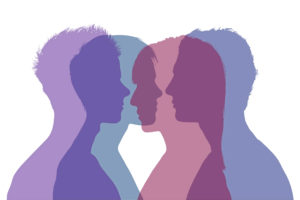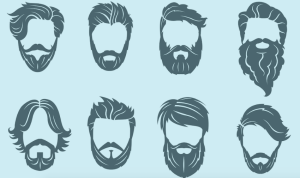
Four superimposed silhouettes in varying shades of pink, blue, and purple.
Today, I’m a feminist writer. But as a teenager, I ardently declared that I wasn’t a feminist.
I really was, but I didn’t know it – because the version of feminism I learned was totally alienating to me.
My first impression came from a teacher who believed that gender inequality existed because men were naturally aggressive. She thought that liberating women meant letting them “be women” – that is, embracing how nurturing, peaceful, emotional, and group-oriented we supposedly are.
As an individualistic, career-oriented, non-binary woman with legitimate anger I wanted validated, this view was totally contrary to my own liberation.
Being myself meant giving myself permission to not be feminine. It meant letting myself be sexual, aggressive, logical, and unconcerned with my looks, the way men supposedly were. And fortunately, I discovered a different brand of feminism that let me do this.
This new brand of feminism didn’t exclude women who wanted to wear makeup or be stay-at-home moms. But it also didn’t claim women were innately this way. It didn’t claim, as other feminists I’d known did, that women who acted “like men” were just brainwashed by the patriarchy and needed to get in touch with their true nature.
Therefore, that brand of feminism – sometimes known as social constructionist feminism because it states that gender is a social construct – was suited not only for me, but also for more stereotypically feminine women.
And the brand of feminism that advocates “embracing differences between men and women” – sometimes called essentialist feminism because it posits that there’s an “essence” specific to women – isn’t necessary for either group.
You can embrace differences between people without grouping them into two types, and you can stand up for your right to be feminine without speaking for a whole group.
Here are a few reasons why I cannot get onboard with feminism that accepts gender essentialism – and why you shouldn’t either.
1. It Ignores LGBTQIA+ People
When we talk about embracing men’s and women’s differences, we’re often assuming that they’re yin and yang – and that those are the only genders.
People who buy into this kind of feminism often think that in order for the world to function optimally, we need a balance of masculine and feminine energy, and the suppression of women has thrown that equilibrium out of whack.
While it’s true that we could stand to value more things society has coded as feminine, like the Earth, and value stereotypically “masculine” things like aggression less, ascribing “masculinity” and “femininity” to everything (including people) erases the LGBTQIA+ community.
Many people don’t identify as men or women. In the view of the world as a balancing act between two “opposite” genders, they have no place.
And by attributing masculinity and femininity to people based on the gender they were assigned at birth, we’re ignoring the many people who don’t identify that way.
Thirdly, the language of “embracing our differences” often either utilizes sexual metaphors about “both” genders being necessary for conception, or is directly applied to romantic relationships, which overlooks all the relationships that are not between a cis man and a cis woman.
As a non-binary person, this belief system certainly ignores me. It states that because I have a vagina, I am therefore a woman – and that that means I should adhere to femininity.
By letting me know my genitals don’t have to determine my identity or anything about me, constructionist feminists have empowered me to define myself.
2. It Groups All Women Together
When we ignore all the ways gender is socially constructed and pretend there’s a transcendent essence of “womanhood” that permeates every culture, we ignore all the ways gender is different in different cultures and subpopulations within them.
We also fail to practice intersectional feminism – the kind of feminism that takes into account factors other than gender, like race and class, that affect how someone experiences oppression.
When we talk about embracing women’s role as homemakers, for example, we ignore all the women who can’t afford to be homemakers because they need to work.
Very often, the mainstream ideal people are talking about when they “celebrate femininity” is one that fits privileged women.
Therefore, essentialist feminism functions to let white women speak for women of color (who, by the way, are more likely to be living in poverty); straight, cis women speak for queer and trans women; and wealthy women speak for working-class and poor women.
When we say “women,” but what we really mean is “women whose perspectives have mainstream representation,” we’re leaving a lot of people out of feminism.
3. It Ignores Similarities Among Different Genders
Essentialism has a dual effect: It obscures differences within groups and obscures similarities between groups.
The gender binary, for instance, paints all men and all women as the same and makes men and women out to be completely different, all while ignoring non-binary and trans people.
Even when these differences are framed in a positive way, they alienate us from one another. This contributes to women’s dehumanization by implying that men can’t empathize with women, since they’re supposedly so different.
Pretending men and women are totally different also creates pressure to conform to stereotypes.
Even if we think we’re just talking about how men and women are, not how they should be, that’s a slippery slope. When a man feels like he’s not acting “like a man” or a woman feels like she’s not acting “like a woman,” these people are made to feel weird.
Combine this with a cis- and heteronormative model of attraction that says men are attracted to femininity and women are attracted to masculinity, and people feel undesirable for not conforming to their gender roles.
In reality, most traits that are considered different between men and women – and expected to exist in some obscure middle ground in non-binary people – actually vary more within each gender.
Across genders, we are more similar than we are different, and looking at one another as relatable despite different socialization allows us to connect instead of exoticizing people.
4. It Encourages Benevolent Sexism
Feminists who advocate celebrating women’s uniqueness aren’t hating on women. They’re usually naming qualities they consider wonderful.
I’ve heard essentialist feminists say, for example, that women can juggle multiple tasks at once, think in a nonlinear fashion, understand others’ feelings, and avoid impulsive decision-making.
These are indeed traits to be celebrated!
But by celebrating them as qualities of women – rather than just as qualities some people have – we encourage benevolent sexism: the notion that women get their value from being feminine.
Benevolent sexists tend to believe it is men’s job to take care of women in order to show respect, since they believe women are more delicate and fragile. They also tend to believe that women are worthy of such respect because of their “womanly” qualities, which implies that less feminine women are worthy of less respect.
Benevolent sexism pressures women to always be nice and submissive, since that’s supposedly what makes them praiseworthy.
Women don’t need to be praised for their beauty and gentle charms. They need to be told they are worthy even if they’re not beautiful or gentle.
5. It Furthers Toxic Masculinity
In addition to having ideas about what women are like, people who advocate “embracing our differences” usually have a specific idea about men. And it’s also usually based on stereotypes.
Viewing the universe as a balance of complementary masculine and feminine energies often involves viewing men as problem-solvers, protectors, and sources of strength and stability. This implies that women need men to provide these services and that it’s not okay for men to need anyone.
It also depicts men as violent at their extreme, which trivializes violence and neglects the suffering it usually stems from by making it seem natural.
This gets especially problematic when we consider men and women complimentary, because under this logic, it’s women’s job to “balance” men out. We’re expected to do the emotional labor of putting up with insensitive men and trying to make them more sensitive.
The same way women don’t need to be told they’re nurturing and delicate and beautiful, men don’t need to be told they’re valuable only because of the protection and strength they offer women. They need to have a sense of self-worth in the face of strong women who don’t need them, and they need to know that anybody can be the “feminine” one.
6. It Furthers the Patriarchal Beliefs Feminism Should Be Against
Benevolent sexism is sneaky because it furthers patriarchy under the guise of feminism. When we celebrate an abstract generalization about how women are, what we’re really celebrating is gender roles.
The idea that women are more nurturing comes from the convention that we stay at home while men have careers, because we’re only considered valuable in relation to other people.
The notion that we’re more beautiful stems from the belief that our looks are the most important thing about us.
The belief that we’re more peaceful comes from centuries of stifling our anger so toxically that we take it out on ourselves.
In order to fight the patriarchy, we need to get to the root of it. And at that root is the gender binary.
By celebrating only women and men who operate within the gender binary, we’re not uprooting it. We’re just watering the plants that grow from those roots.
***
Feminism is about the ability to speak for yourself – and essentialist feminists try to speak for us. They try to tell us what our personalities, interests, and goals are on the basis of our gender.
In doing so, they may be trying to help women be themselves, but what they’re really doing is expecting women to be their version of what a woman is. And that version comes from the patriarchal beliefs that feminism is supposed to be against.
Again, it’s no problem for women to have “feminine” traits themselves and be proud of them. But attributing them to women as a group limits people of all genders and furthers the oppressive system that led to those generalizations.
All the good things that come out of embracing differences and femininity can still be retained when we admit gender is a social construct.
That way, we’re giving everyone the freedom to be who they are without telling them who that person is.
[do_widget id=’text-101′]
Suzannah Weiss is a Contributing Writer for Everyday Feminism. She is a New York-based writer whose work has appeared in The Washington Post, Salon, Seventeen, Buzzfeed, The Huffington Post, Bustle, and more. She holds degrees in Gender and Sexuality Studies, Modern Culture and Media, and Cognitive Neuroscience from Brown University. You can follow her on Twitter @suzannahweiss. Read her articles here.
Search our 3000+ articles!
Read our articles about:
Our online racial justice training
Used by hundreds of universities, non-profits, and businesses.
Click to learn more




















